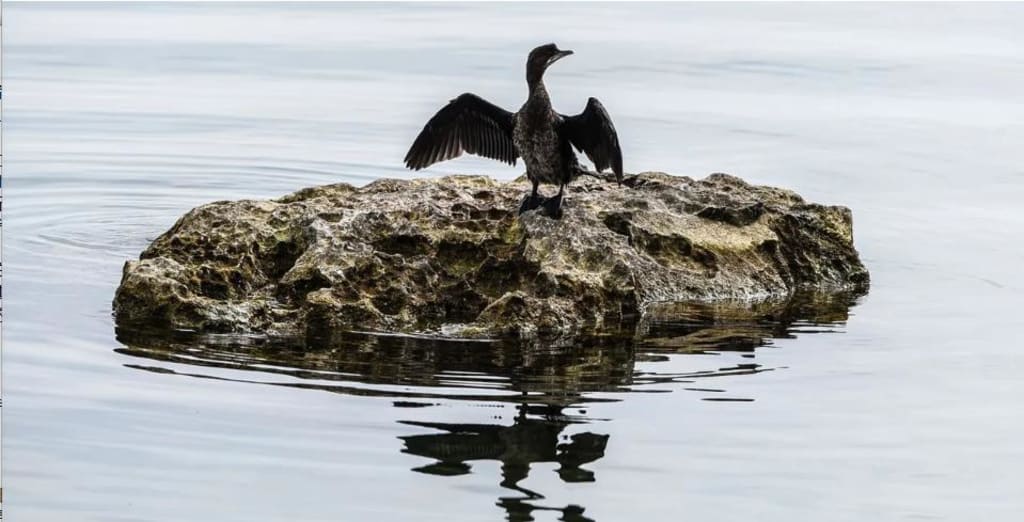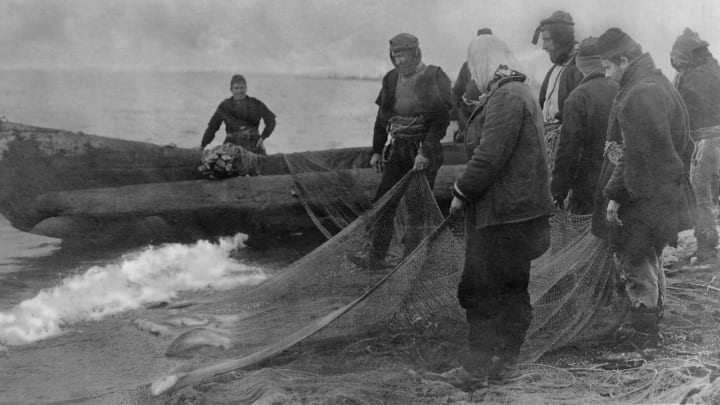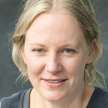The neglected 'Galapagos of Europe'
Beneath its misty surface, southern Europe's Lake Ohrid is the most densely biodiverse lake in the world. Now, fishermen are helping save its "living fossils" from extinction.

It's around 8am and there's a chill in the air as I look out across the foggy horizon of Lake Ohrid, which sits on the border between Albania and North Macedonia. A cluster of small wooden fishing boats, painted in bold primary colours, slowly grow larger as they move towards the shore.
One pulls up to the bank beside me, where an old man in a battered baseball cap is waiting to buy the fisherman's haul. The fishermen go out on the lake every morning, starting at 4am, to catch the Ohrid trout – known on its Albanian shores as "koran". It's a species that exists only in this lake, and is in high demand all around the region thanks to its delicious light pink flesh, which is usually grilled or baked. It has been popular here since medieval times, when it was celebrated in poetry.
The problem is, this popularity is now threatening its existence. Back in the 1990s, the annual catch on the lake was more than 120 tonnes. From 2012-2018, it averaged 61 tonnes. "Thirty years ago, we could go out with about five lines and catch 30kg [66lb]," says Roland Bicja, a fisherman from Lin, a picturesque, wildflower-filled village nestled on the Albanian side of the lake's shore. "Now, we put 100 hooks in and barely catch 3kg [6.6lb]."
Every family here has a long history in fishing, and each house has its own boat moored outside. Bicja's father and grandfather were both fishermen, and he describes going out on the lake every morning as an almost spiritual experience: "When I'm on the boat, it's like [my father is] still there with me."

But Bicja and his colleagues know they are in a precarious situation. They need to catch the Ohrid trout for their income but, if they catch too much of it, there may end up being none left – and there will be no livelihood left for the many people who work on the lake.
Ohrid is one of the oldest lakes in the world and is thought to have formed around six million years ago
That's why he and his fellow villagers are now part of a project that aims to restock the lake with Ohrid trout, while keeping fishermen employed. From December until March, when the fish is spawning, commercial catches are banned on the lake. Instead, the fishermen are paid to capture the trout, harvest the sperm and roe without killing the fish, and artificially fertilise the eggs.
These are then taken to a local hatchery, where they hatch and grow for 10 months. The fishermen are later paid to release them back into the waters. It's both an environmental and social solution for a problem facing freshwater fishing communities all around the globe.

Ohrid is one of the oldest lakes in the world and is thought to have formed between four and 10 million years ago. Its hypnotic blue-green waters are surrounded by snow-capped mountains, and multiple towns and villages sit on its banks on both the Albanian and Macedonian sides.
The site has long been considered a holy spot in Orthodox Christianity, and the largest Macedonian town here – also called Ohrid – is thought to have once boasted 365 churches, or one for every day of the year. The Cyrillic alphabet, which is used in many Slavic languages including Russian, was also developed here at the Ohrid Literary School. The entire lake was declared a Unesco World Heritage Site in 1979, due to both its cultural significance and its immense natural beauty.
However, this special place is under threat from more than just overfishing. Construction and pollution have also increased over the past decade due to a tourism boom. "Back in 1979 it was pristine," says Mechtild Rössler, director of the world heritage centre at Unesco. "But over time, it became a matter of concern."
The lake itself is often referred to as the European Galapagos due to the high number of species found nowhere else but here. There are 212 in total, spanning the entirety of the food chain – from algae and zooplankton to plants, snails and worms. There are 17 fish species in total, of which eight are endemic. The lake is described by scientists as "a museum of living fossils", says Spase Shumka, a professor at the Agricultural University in the Albanian capital of Tirana. In its six million years of isolation, the species within it were able to evolve uniquely. According to Unesco it is by far the most biodiverse lake in the world, if size is taken into account.
Shumka explains that the lake is oligotrophic, "which means it's a clear lake with few nutrients in it". This makes the water beautifully clear, and safe for even humans to dip their hands in and drink from. However, it also means it has a low productivity – in other words, fish reproduce at a far slower rate compared to most other lakes.
The species here have evolved to thrive in these unusual conditions, including the Ohrid trout. It takes around five to six years to reach sexual maturity, and even after that only has 2,000-2,500 eggs per kilogramme of body weight. In comparison, a carp has 500,000. It is also very dependent on the unusually high oxygen level of the lake, and can only survive in water that is maximum 15.6C (60F). But this delicate evolution within Lake Ohrid makes the fish vulnerable to change.
Shumka describes the lake as a "top-down ecosystem" – the Ohrid trout, which is one of two main predators along with the Ohrid chub, controls the populations of all species further down the food chain. If its numbers drop, it impacts the entire lake.

A plan to replenish the Ohrid trout was first developed by scientists on the North Macedonian side all the way back in 1935, when it was part of pre-Communist Yugoslavia. Back then, fishermen would catch the creature using trawling nets when it was spawning season and the trout was swimming close to the shore. A local limnologist, Sinisha Stankovic, understood that this was playing havoc with the fish reproduction. He established a system where fishermen would harvest eggs and sperm from the trout before selling them on the market, and founded the Ohrid Hydrobiological Institute where the artificially fertilised eggs could be hatched.
After World War Two, both Albania and North Macedonia were ruled by communist regimes, the latter as part of the former Yugoslavia. Throughout this period, the environmental situation on both sides was reasonably stable. Fishing was only carried out by state-owned companies, and so the number of trout being caught was well controlled. The artificial fertilisation also kept the numbers buoyant. Bicja remembers how, as a child, he used to look out from his house and see the lake's clear waters filled with fish. "We weren't allowed to catch them ourselves in those days," he remembers. "But I used to swim out myself and fish with hooks, when I was about 12."
Everything changed in the early 1990s. The regimes on both sides collapsed, leading to widespread chaos. All the rules and systems that had previously been in place were now gone. Albania in particular suffered from extreme poverty. With the Ohrid trout still one of the most popular commercial fish in the region, and weak authorities regulating activity, many desperate people saw an easy way to make money. "Suddenly, everyone was on the lake," Bicja remembers. "There were one hundred, maybe two hundred boats out there."
The situation continued for years, creating a dent in the trout populations that the lake is still trying to recover from, according to Zoran Spirkovski, the head of applied fishery and agriculture at the Ohrid Hydrobiological Institute. He tells me that he and his colleagues began to cooperate with the Albanian side of the lake in the 1990s to try to find a solution.
"There was an old hatchery at Lin, which had been used for farming rainbow trout during the communist period," he says. "That was an alien species, which is not in accordance with our environmental laws. But we thought the premises could be reconstructed."

In 2005, the World Bank agreed to fund a refurbishment of the hatchery, giving it capacity to produce one million fingerlings (young fish) each year. On the Macedonian side, another 2.5 million are bred. I visit the hatchery during my trip to Lin, shortly after meeting Bicja. It sits at the end of the village, past fields thick with the scent of spring onions, which are currently in season. Birds chirp loudly around me and lizards dart across my path as I make my way there.
I meet with Celnike Shegani, who has been running the hatchery ever since it reopened. "These fingerlings are my life," she says. "Even my grandchildren ask me, 'How are the fingerlings doing?' as soon as they see me." Restrictions have been brought in on fishing in Albania since the chaotic years of the 1990s, and now everyone must have a license and be a member of the local fishing association.
The process for fertilising the eggs has also been refined over the years to best suit the Ohrid trout species. Back in the 1930s, fish were sold on the market after having their eggs harvested. As the Ohrid trout can reproduce many times in its lifetime, selling fish commercially during its spawning period is now banned. Instead, fishermen capture it live, collect the eggs and sperm, and mix them together in a bowl of water to fertilise them. A state worker then comes and buys the live fish back, and takes the eggs to the hatchery. Celnike picks up some fingerlings to show me – they're about two inches long, and wriggle and sparkle in the light. "They're about 400-600 milligrams, and around four months old now," she says. When they reach 4g, the fishermen will collect and release them.
The process on the Macedonian side has also evolved. Spirkovski tells me that ideally the fertilisation should be carried out by scientists rather than fishermen to ensure the optimum number of eggs are used, but Albania lacks the resources for this. Instead, in North Macedonia, fishermen are just paid to help catch the trout and bring them to a large research boat. Clove oil is used as a natural anaesthetic while the eggs are harvested.

The restocking project is considered by experts such as Shumka to be helping, but there is still a lack of data on how many released fish survive. "I introduced a method where 5% of fingerlings would have a silver wire inserted in their snout," Spirkovski explains. The mature fish caught in the catch would then be tested with a metal detector, to estimate how many of that cohort survived. But unfortunately this part of the project hasn't been rolled out. "We don't have the funds," says Shumka. "We would need to compensate the fishermen for the commercial fish loss."
On the Macedonian side, there is currently a total ban on fishing Ohrid trout until precise data can be gathered. On the Albanian side, although fishing is better controlled than it used to be, experts believe there should be a ban on catching the trout before it has reached a certain size due to the long time it takes to reach sexual maturity. "I always throw fish back in if they are small, but you do see people keeping and selling them," Bicja agrees.
Illegal fishing also still takes place on the lake, even though the fishermen's association has the authority to confiscate their equipment when caught. "I don't know if it is possible for anywhere to get rid of this completely," says Spirkovski. "We can only work to try to reduce it."
Those who live by the lake and depend on it for their livelihoods hope they will one day receive the assistance they need to conserve this unique place. Two years ago, Ohrid was recommended for inclusion on Unesco's heritage in danger list. Should it be added in future, it would encourage the international community to take notice. "There has been some progress," says Rössler. "But there is still a cumulation of problems. More must be done to preserve this pristine nature."
Regardless of the international perception of the fish, here at Lake Ohrid, the people who depend on the lake know what it means. "Ohrid trout is the most important thing we have here in our village," Bicja concludes. "Everyone needs to care about it, and understand how special it is."
About the Creator
Fra Tusha
stay hungry, stay foolish.
Enjoyed the story? Support the Creator.
Subscribe for free to receive all their stories in your feed. You could also pledge your support or give them a one-off tip, letting them know you appreciate their work.






Comments
There are no comments for this story
Be the first to respond and start the conversation.